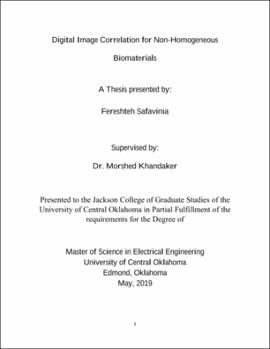| dc.description.abstract | The Digital Image Correlation (DIC) is the optical and noncontact method to measure deformation and full- field strain of a loaded object. In general, DIC method is used for homogenous materials, whose composition, shape, and texture are the same throughout the materials like aluminum, copper. There is no established DIC method for a non- homogenous material, which is not uniform, such as bi-material interface surfaces. The goal of this study is to apply DIC method to a non-homogeneous system to evaluate the mechanical response due to applied load. In this study, DIC method was applied to three different non-homogeneous systems: metal/cement, bone/cement and multi-layers' fiber cloth. The first objective was to measure the strain at the interface of aluminum and cement by using DIC method. In order to understand the deformation characteristics, a series of images were taken by high speed camera, Phantom V641. Using a Matlab program of DIC method, the full-strain at the interface was found. The second objective was to find the full strain at the interface of bone-cement-aluminum in a knee replacement surgery. The third objective was to find the strain of the rolled fiber cloth that can be used for biomedical applications. The fiber was obtained from the existing electrospinning system and the procedure was repeated to find the strain value of the fiber. The research successfully measured the deformation characteristics of aluminum - cement interface using DIC method and compared the values with mechanical of materials theoretical values. This study also measured deformation characteristics of bone-cement- aluminum interfaces for a total knee replacement system and compared the values with the computer model. Finally, the strain field of rolled fiber was measured and compared the values with a plastic material model. The DIC protocol developed in this study can be used to measure the properties of the materials around the interface of two bi-materials and multi-layers fibrous materials. The developed techniques will be useful for the development and design of orthopedic biomaterials. | en_US |
